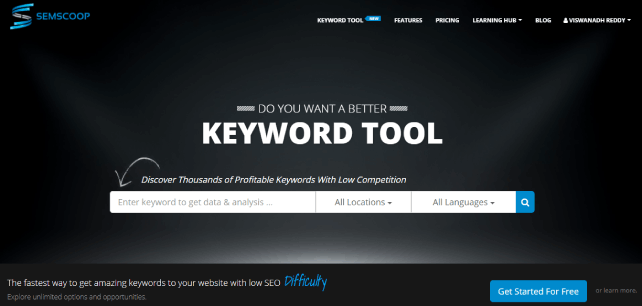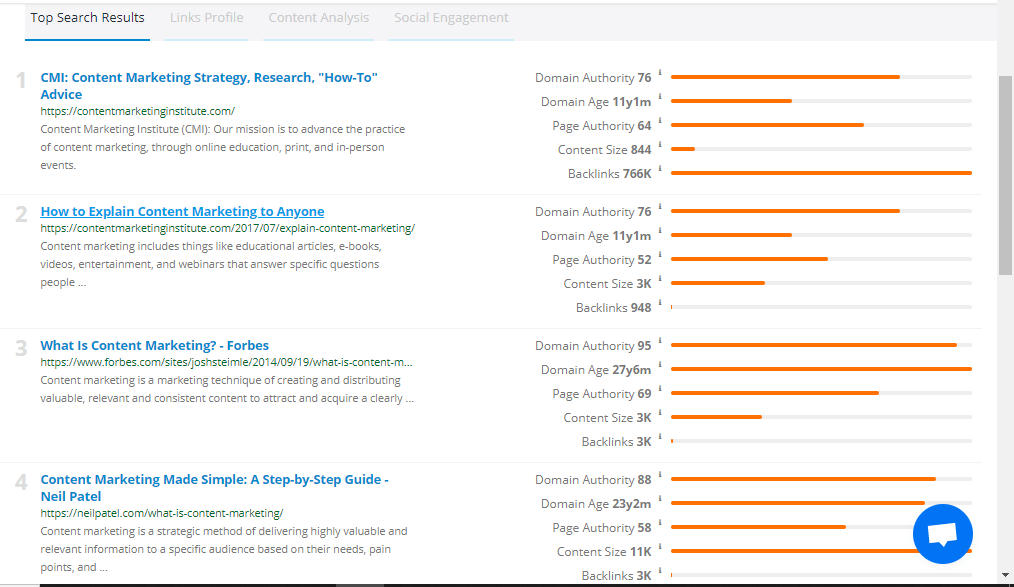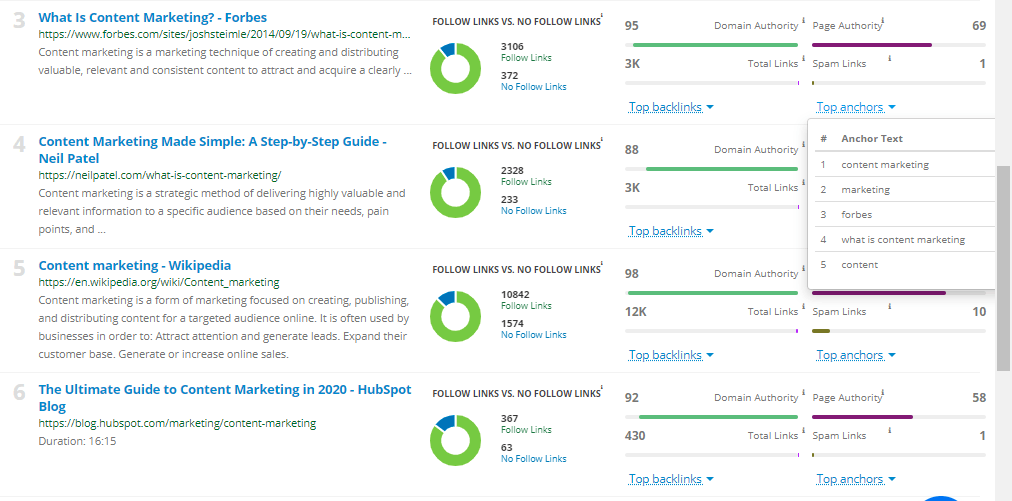SEMScoop is another new tool that’s gaining steady popularity among the new keyword research tools.
When I used this tool, I was really surprised mainly by their keyword top search results analysis and content analysis. Which I felt a bit unique, especially in the representation of data.
I feel the data provided by them is quite useful.
So, I thought to do a complete SEMScoop review such that it can help the users with their keyword research and SERP analytics.
Another great thing is the pricing of their paid plans, which is reasonable and decent.
They do have a free plan, where they offer limited searches and results.
Let’s dive into the topic

SEMScoop Review
First of all, you can do keyword research specifying the location and the language basing upon your target audience. You can even keep all locations and all languages that come as default for your searches.
Once you are done with the search, you will end up on a search page with the keyword details
What you can see in the results
- Keyword Ideas
- SEO details like search volume, CPC, PPC
- Target keyword searches by month (1 year of results)
- Keyword difficulty score
- Analysis of top search results
- Link profile of the top results
- Content analysis of the pages to your target keyword
- Social media engagement analytics
What I like about SEMScoop
- Representation of data is good
- Simple layout
- Content analysis and SERP analysis features are helpful
- Keyword difficulty score is good
- Keyword ideas list with details of search volume CPC and PPC
- Export option and decent pricing
What I do not like about SEMScoop
- You can’t do much other work other than keyword analysis (but for the pricing, I think it’s ok)
- Small font size, especially in the results (sometimes makes me out focused)
- Social engagement metrics is not up to the mark

Now let’s get into the detailed SEMScoop review, where I will give you a clear picture of all the features this Keyword tool offers.
Keyword Ideas
SEMScoop can show up to 700 keyword ideas basing upon your target keyword.
In the free plan, they show around 50 keywords.
In their basic plan, the limit is around 300 results per search. which I think is a decent amount for most of the results
Their keyword ideas are good enough to find new topics.
SEMScoop is also giving the details of search volume, CPC, PPC along with the keyword ideas, which is good such that you need not check again for search volume and CPC.
They had also provided filter, sort, and export options.
Keyword Metrics and Difficulty Score
I personally believe that the keyword difficulty score is crucial for success.
Ranking for a highly competitive keyword is not an easy thing for new blogs.
If you are new to blogging, I recommend you to initially start with low competitive keywords until your domain attains some authority.
Coming to the SEMScoop keyword difficulty score review, I think it’s fine to use.
I had also checked a good number of the keywords I was ranking for in other domains and compared them with the scores they gave.
I found that some of them matched with the expectation, and some were close, and some didn’t.
Overall, I think their difficulty score was ok to get an idea.
I think keywords that show their SEMScoop difficulty score of lesser than 25 or 30 are good to go.

Coming to other metrics, SEMScoop also gives a breakdown of monthly searches of the past 12 months to the target keyword. It’s really useful to identify whether the keyword is a seasonal one or to see any fluctuations in the trends.
SEMScoop also gives average domain authority, domain age, links, and content length basing on its analysis, which is good.
Regarding the content length, it is ok in some of the cases, but I also see a lot of deviation.
A point to be noted is its content length (which might include comments and other words present), Not the word count of the actual article.
The feature is ok to get a primary analysis. However, there is a lot more room for improvement, especially in this area.
Top Search Results Analysis in SEMScoop

Let’s now look at the SERP analysis part.
In the top search results area, SEMScoop shows the details of the top SERP results along with some SEO metrics.
It shows the title, URL, meta description of the results along with domain authority, page authority, age of the domain, content size, and the number of backlinks pointing to the URL for every result they displayed.
Also, they represent them in a scale bar, which gives a clear view to the user. You can see those details and estimate whether your domain can be a good competitor or not to that specific keyword.
The thing I felt a bit uncomfortable while working with their tool is the text size. Sometimes I felt a bit out focused when seeing the data continuously on a laptop- it can be more if you use a 13-inch laptop
Other than that, everything is fine.
Link Profile

Coming to the link profile, I think SEMScoop had done a pretty good job in representing data.
Their details of follow vs no follow links, total link count, and spam link count is pretty useful.
You can also view the details of 3 top backlinks and 5 top anchor texts.
Altogether, link profile can give a basic idea about the links for the bloggers to estimate the plan about the focus keyword.
If you are looking for a tool that comes with complete link profile, then you need to rethink twice.
Content Analysis
Let’s talk about the SEMScoop content analysis now. This is one of the unique features that can be seen in SEMScoop.

Basing upon the keyword you set it analyses the content in the top search results and gives the details of on page SEO score, length of the content, and keyword density, which are useful to get a view on density and content length of your competitors.
Apart from that, SEMScoop also analyses the total content and gives details like the presence of keyword in the title, URL, H Tags, image alt tag, style, and description.
I felt that the data useful to get an idea of what needs to be optimized for sure and what is not important by analysing your competitors.
Social Engagement Metrics
In the social engagement part, SEMScoop had done a good job to show the engagement rates of those domains with respect to their post on social media.
SEMScoop shows results of Facebook, LinkedIn, StumbleUpon (now Mix), and Pinterest engagement.
But I didn’t find it useful sometimes as no metrics appears and I doubted, does these articles don’t have a social activity, and though no way.
SEMScoop Plans and Pricing
SEMScoop offers a free plan, limiting to 5 searches per day, 10 keyword analysis, and 50 keyword results (ideas) in results.
If you have a limited budget, a free plan is also fine to meet some of your requirements.
Coming to the paid plans, SEMScoop offers 3 paid plans: Basic, Pro, and Business, to meet your needs.
The Basic plan starts at 9$ per month. When you subscribe for an annual subscription, you get it for a much lower price as SEMScoop may offer a discount on their annual subscription.
Currently, they are offering 20% savings on annual subscription on the basic plan, that comes at a price of 89$ per year (7$ per month).
If you just started your blog, I prefer you to go with their basic or pro plans basing up on needs like preparing a keywords list or database for your website. If you are an established blogger searching for more profitable keywords, I prefer to go with their pro plan.
If you have an enterprise, then check out their business plan.
Conclusion
SEMScoop is a great tool designed to get a complete analysis about your target keyword.
Their difficulty score, content analysis in a keyword centric way, SERP analysis, and basic link profile gives a complete idea to you whether you can rank for that target keyword or not.
You can get a clear picture of what’s needs to be done while writing content with respect to your keyword, like how much keyword density you need to maintain, whether you require a keyword in h2 -h3 tags basing on your competitors, how much should be the length of your content and so on.
Moreover, SEMScoop pricing is also decent and affordable.
But, be known that its a keyword research tool, you cant do much on things like link analysis, complete site profile etc.
If you aren’t satisfied with SEMScoop, you can check out the post best keyword research tools to find the tool you wish to have.
I think my detailed SEMScoop review had helped you.
Leave us a comment below and subscribe to our newsletter to know more details.



